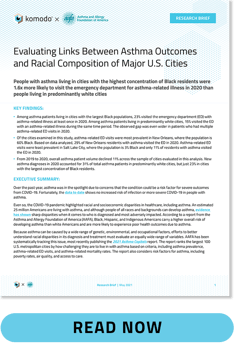Does the Racial Composition of a City Affect Asthma Outcomes?

 When a novel respiratory virus – what we now know as COVID-19 – began to grip the nation last spring with stories describing ventilator and oxygen shortages, the cause for concern for asthma patients was palpable.
When a novel respiratory virus – what we now know as COVID-19 – began to grip the nation last spring with stories describing ventilator and oxygen shortages, the cause for concern for asthma patients was palpable.
Asthma is a chronic disease that affects an estimated 25 million Americans, and although people of all races and backgrounds can develop asthma, evidence has shown sharp disparities when it comes to who is diagnosed and most adversely impacted. According to research from the Asthma and Allergy Foundation of America (AAFA), Black, Hispanic, and Native American people carry a higher overall risk of developing asthma than white Americans, and they are more likely to experience severe adverse health outcomes as a result.
Fortunately, the fear that asthma would be a risk factor for severe outcomes from COVID-19 has not materialized in the literature. But COVID-19 did disrupt every facet of the healthcare landscape, exacerbating existing health disparities in the process. With a preexisting racial chasm of disease burden for asthma, the opportunity to better understand racial disparities in asthma care, and how that inequity played out during the pandemic, became an area of great interest.
Using city-level racial prevalence information from the U.S. Census Bureau alongside healthcare utilization data in Komodo’s Healthcare Map™, we teamed with AAFA to examine the frequency of asthma diagnoses and emergency department (ED) visits associated with asthma and telehealth utilization in major U.S. cities, based on high and low percentages of Black residents. The following highlights from the report:
Black Communities Sought More Emergency Asthma Care: Among asthma patients living in cities with the largest Black populations, 23% visited the ED with asthma-related health issues at least once in 2020. Among those living in predominantly white cities, 15% visited the ED with an asthma-related illness during the same time period. We found an even larger gap for patients who had three or more asthma-related ED visits during the year.
New Orleans Was the Epicenter of Asthma ED Visits: Of the cities examined in our analysis, asthma-related ED visits were most prevalent in New Orleans, where 29% of asthma patients visited the ED in 2020. Asthma-related ED visits were least prevalent in Salt Lake City, where just 11% of asthma patients visited the ED in 2020. New Orleans is nearly 60% Black, whereas Salt Lake City is less than 3% Black.
Overall ED Visits for Asthma Declined: Overall asthma patient volume declined 11% from 2019 to 2020 across the sample of cities evaluated in this analysis, and a drop in the percent of asthma patients who presented to the ED with an asthma-related complaint was seen regardless of demographics. The most significant dropoff in ED visits occurred in predominantly white cities, where ED visits were 3.68% lower than in 2019. Multiple factors may explain this drop in patient volumes and ED visits during 2020. Exposure to allergens outside the home decreased in 2020 due to shelter-in-place orders, likely decreasing the number of asthma exacerbations. And, recommendations to avoid hospital settings due to COVID-19 likely led people to seek other settings of care, such as ambulatory clinics. The greater decline in ED utilization in cities with predominantly white populations, however, does suggest that patients in high-minority areas, who often do not have as robust access to primary care physicians and ambulatory clinics, were still more likely to use the ED.
While a steadily growing body of evidence has proven that social determinants are among the more significant drivers of health outcomes, health disparities in distinct demographic groups continue to be a challenge for the U.S. healthcare system. These data are further indication of that. As healthcare providers, public health officials, and other healthcare stakeholders continue to focus on addressing health equity in the aftermath of the COVID-19 pandemic, it will be essential to keep measuring and addressing these and other gaps in care.
To read our full research brief, click here.





